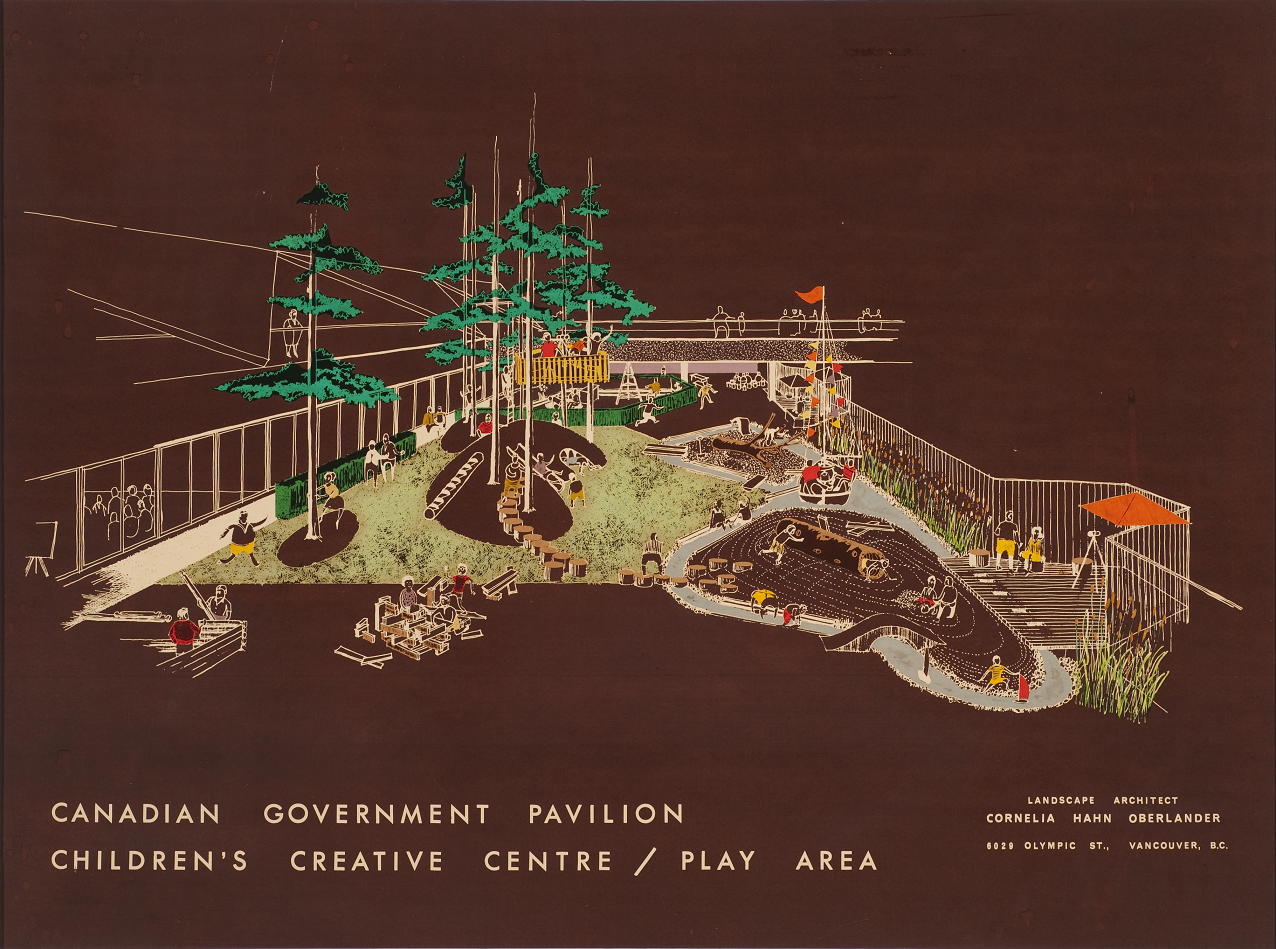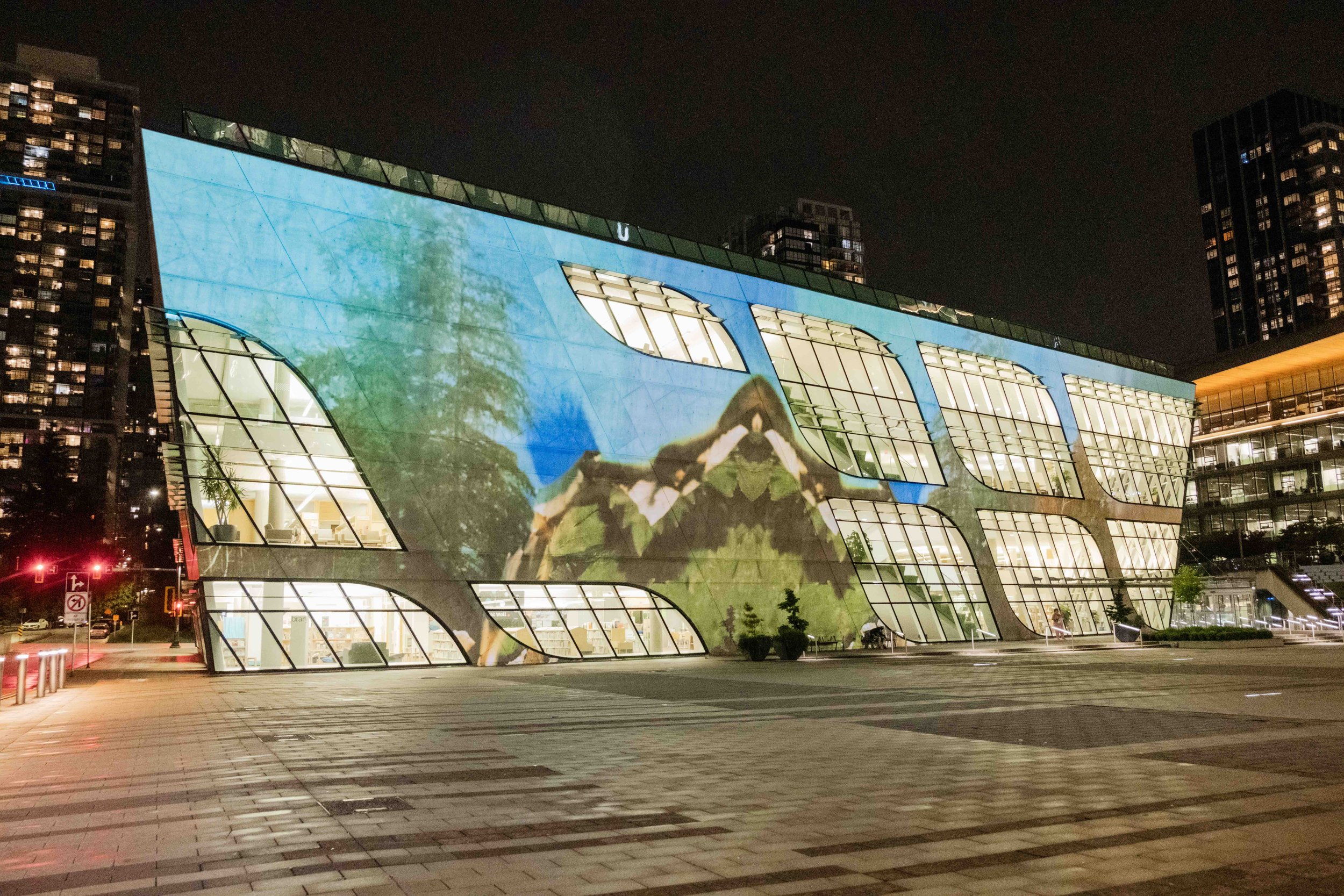Cornelia Hahn Oberlander exhibition at West Vancouver Art Museum celebrates landscape designer’s legacy
Genius Loci presents a body of work spanning seven decades of the visionary artist’s career
Cornelia Hahn Oberlander, Perspective view for Children's Creative Centre Playground, Canadian Federal Pavilion, Expo '67, Montréal, Québec, ca. 1967, dry transfer on negative photostat printed on cardboard, 91 x 114 cm. ARCH252723. Cornelia Hahn Oberlander fonds, Canadian Centre for Architecture. Gift of Cornelia Hahn Oberlander, ©Cornelia Hahn Oberlander.
Cornelia Hahn Oberlander: Genius Loci runs at the West Vancouver Art Museum from January 20 to March 13
CORNELIA HAHN OBERLANDER—one of the world’s greatest landscape architects and one of the few women in the field—is being celebrated in a retrospective exhibition at the West Vancouver Art Museum. A leader in sustainable design and a pioneer of Green roofs who’s credited with bringing people closer to their natural environment, Oberlander, who’s now in her late 90s, was actively involved in Genius Loci, which encapsulates her extraordinary seven-decade career.
Oberlander fled her native Muelheim-Ruhr, Germany, as a child with her mother (a horticulturalist) and sister for the U.S., living in Massachusetts on a 200-acre farm. She went on to study at the Harvard University Graduate School of Design. In 1953, after working in Philadelphia and Vermont, she moved to Vancouver, where she established her own design firm and where her career flourished while raising three children with her husband, architect H. Peter Oberlander, Canada’s first professor of urban and regional planning. In the early 1970s, she began collaborating with Arthur Erickson, and she continues to create designs for universities, governments, schools, and private residences.
Genius Loci, meaning the protective spirit of a place, is a dream realized for Hilary Letwin, West Vancouver Museum’s acting museum administrator/curator. In an interview with Stir at the museum—the former home of Gertrude Lawson, a teacher and one of the first women in B.C. to have a mortgage in her name—Letwin explains that design and architecture are vital elements of the museum’s programming, alongside art, given the role the municipality has played in the development of West Coast modern design. Over the last decade, the museum has featured work by Fred Hollingsworth, Geoff Massey, Barry Downs, and other important names in West Coast modernism. When Letwin interviewed for the position in 2018, she pitched the idea of an exhibition about Oberlander.
“My thinking was that the art museum had focused on all of these male designers, and of course, it is a very male-dominated field even now,” Letwin says. “My argument was that there was room for looking at the many women who were part of the movement as well, and Oberlander was really at the forefront of that.
“I met with her initially to pitch the exhibition idea, and she and I struck up an immediate liking for each other and had a lot in common,” she says. “And so, over the course of the last few years, I’ve met with her very regularly and she’s had a very strong hand in the planning, and that includes picking the projects we’re highlighting and identifying the themes we wanted to focus on in her work.”
Cornelia Hahn Oberlander.
Genius Loci is presented in partnership with the Art Gallery of Alberta and co-curated by Amery Calvelli. The four categories of the bilingual exhibition (in French and English) are playgrounds, social housing, public projects, and private residences, selected from various stages throughout Oberlander’s career.
Plans, sketches, letters, drawing, proposals, and photographs from the Cornelia Hahn Oberlander fonds – Canadian Centre for Architecture make up Genius Loci. From a courtyard at the Portland Hotel in the Downtown Eastside to the landscape design for Erickson’s Montiverdi Estates in West Vancouver to the taiga garden of the National Gallery of Canada in Ottawa, the exhibition illustrates Oberlander’s interest in the Bauhaus movement and influence of German-American architect Walter Gropius, whom she studied under at Harvard and who founded the Bauhaus School in Weimar.
“[One of] the most important themes to emerge, both in our exhibition but also from her career, is a deep appreciation for research,” Letwin says. “She is a student through and through. She was always trying to get to the technical knowledge around what plants, what particular flora, will flourish on a particular site, and what particular planting media one was using. Bing Thom observed once that she was the pioneer of Green roofs.”
The Vancouver Public Library is one of the public projects highlighted in Genius Loci. Oberlander collaborated on the design with architect Moshe Safdie and architecture firm Downs/Archambault & Partners. Opened in 1995, it featured what would have been the city’s first publicly accessible roof garden; the Green roof was built but never opened to the public. In 2018, Oberlander’s redesign added new roof-garden spaces, finally bringing the design’s original intent to life. Less than 25 percent of the water that falls on the roof gets put back into the storm system.
“There’s this sort of constant quest for research and technological advancement that she’s always been at the forefront of,” Letwin says.
For another example of the exhaustive research Oberlander put into every single project she worked on, consider 2012’s East Three School in Inuvik, two degrees above the Arctic Circle. She developed four playgrounds for students from Kindergarten to Grade 12. Her files include articles about global warming, notes on traditional Northern games like the one-foot high lick, information on edible schoolyards, a matrix of cognitive development, letters by Grade 6 detailing what they would wish for in a play area, and more. She incorporated indigenous flora by turning to resource material such as Inuvialuit Nautchiangit: Relationships Between People and Plants by Inuvialuit Elders with Robert W. Bandringa. As there was no nursery in the area, Oberlander collected local seeds, brought them home to cultivate plants, then transplanted the material back, “with the idea if it grows there naturally, it will continue to thrive in a designed environment”, Letwin explains.
Another theme to emerge is Oberlander’s appreciation for play. She designed the Children’s Creative Centre Playground at the Canadian Federal Pavilion in Montreal for Expo 67 (where some 30,000 children played between April and October of that year). It was a pivotal moment in her career, a time where her three children were still young.
“She felt it was very important that children don’t work with manufactured playground material, but to actually work with a lot of natural materials like sandboxes and water play,” Letwin says, pointing to a rocking boat in an image of the playground on the carefully lit art museum wall. “She had these incredibly technical designs, but the point was really to let children discover things naturally.
“In mid-March, during the initial lockdown, I remember calling her to have a quick chat and she said, ‘What are your children doing during this time?’ I said the playgrounds were closed so I told her I was taking them to our local beach, and she said, ‘Oh, good! That’s the best place you can bring them. Let them climb on the rocks and play in the sand and dig in the mud’—and her ideal playground is really just that.”
Oberlander’s desire to bring humans closer to nature is evident in social housing projects she worked on, from Mills Creek Public Housing in Philadelphia to East Vancouver’s Skeena Terrace. She aimed to not only provide privacy for residents but also to build fruit trees into the landscape design. “She felt like fruit trees brought a certain amount of joy both through the fruit but also through the blossoms in the spring, and they provide beautiful shade in the hot sun,” Letwin says. “There’s just an incredible thoughtfulness that goes into these designs.”
Funded in part by the Department of Canadian Heritage, Genius Loci is accompanied by a publication of the same name. The book features contributions by Oberlander, the exhibition curators, and writers Susan Herrington and Eva Matsuzaki.
Among the honours Oberlander has received are the Companion of the Order of Canada and the highest awards from the American Society of Landscape Architects and the International Federation of Landscape Architects. The Cultural Landscape Foundation, meanwhile, recently announced the Cornelia Hahn Oberlander International Landscape Architecture Prize. (The US$100,000 award will be given biennially, beginning this year.)
“She’s just had this incredible impact on so many people—women, perhaps, in particular—as one of the few leading female landscape architects in Canada and the world,” Letwin says. “I think she’s become this incredible role model.
“I think it’s fitting that the Cultural Landscape Foundation named its first international landscape prize after her,” she says, “because there’s nobody better.”
A curator’s Zoom panel discussion with Oberlander takes place On January 24 at 3 pm. For more information, including details on museum hours, COVID-19 safety measures, and curator’s tours, see West Vancouver Art Museum.














